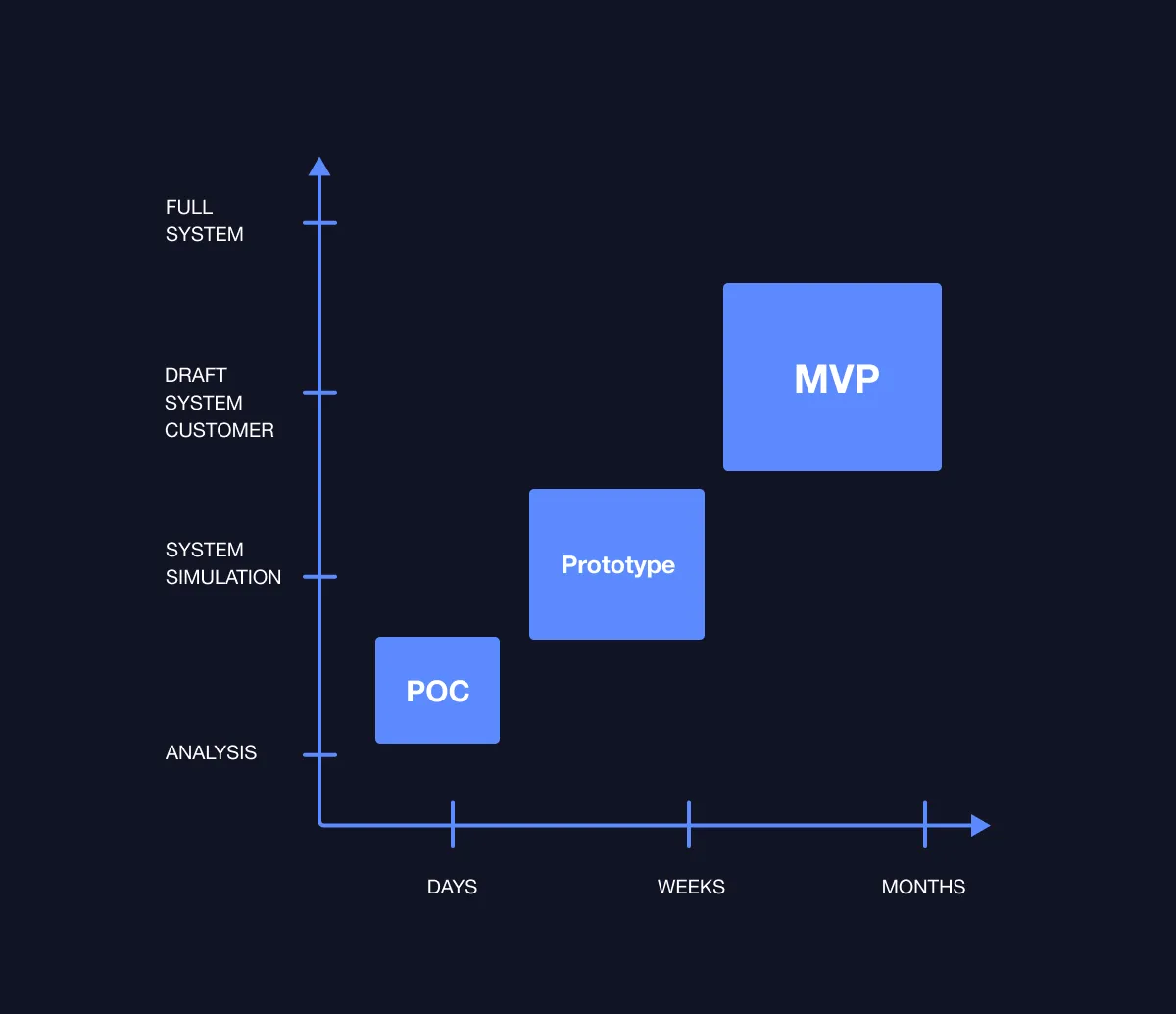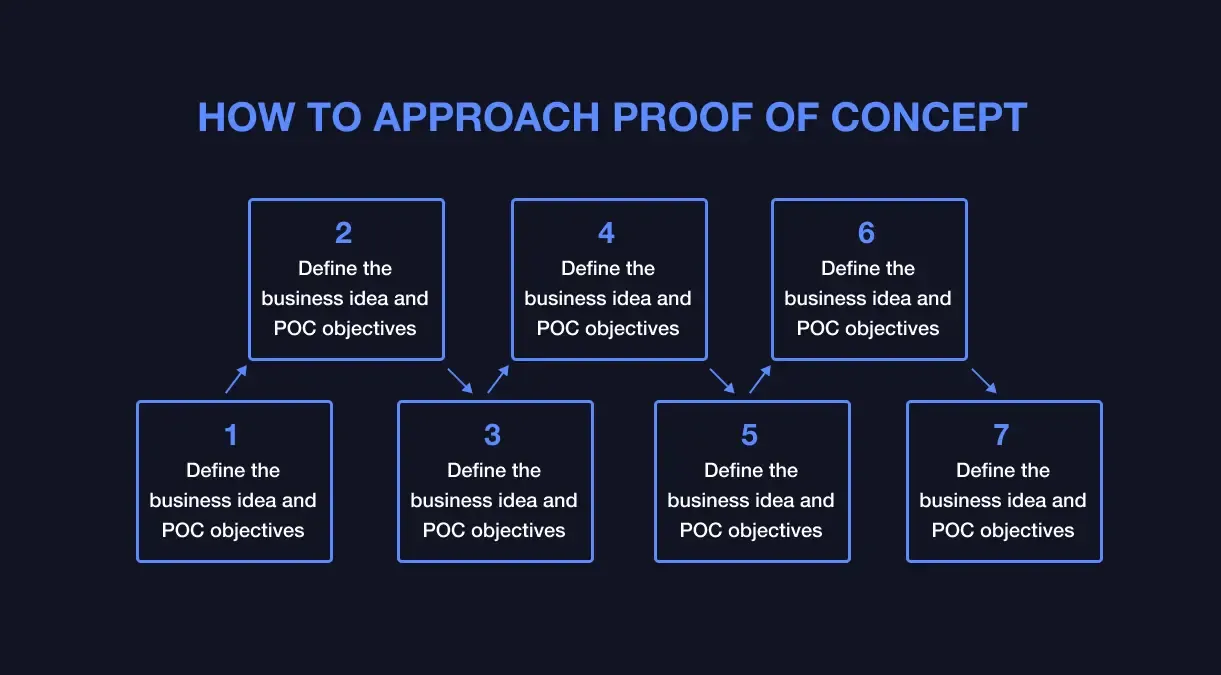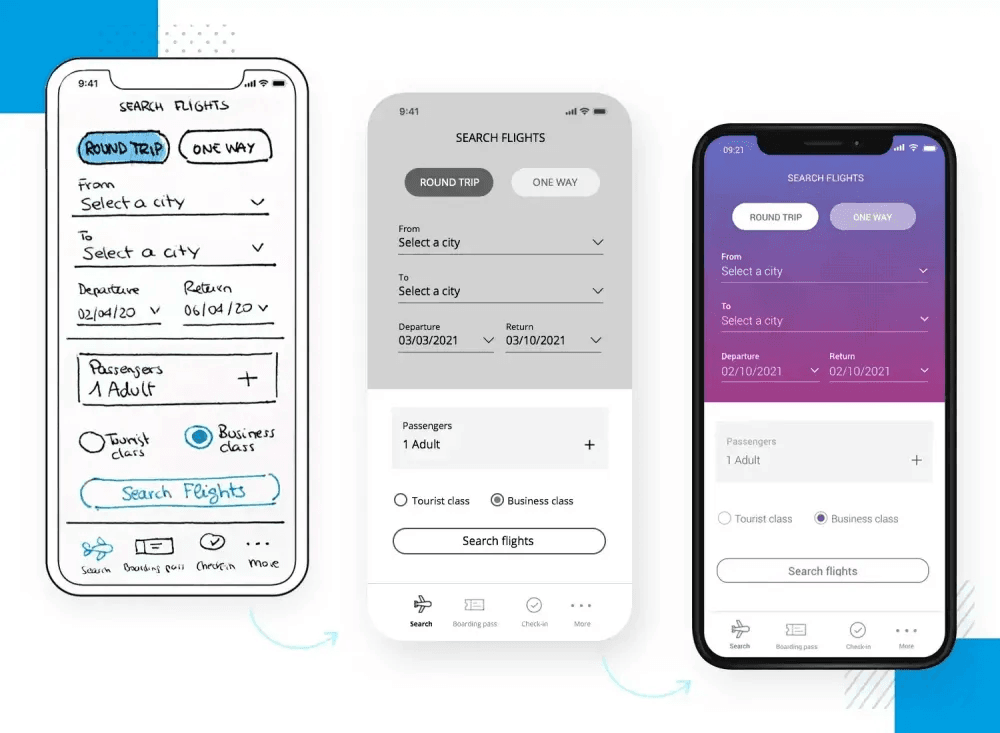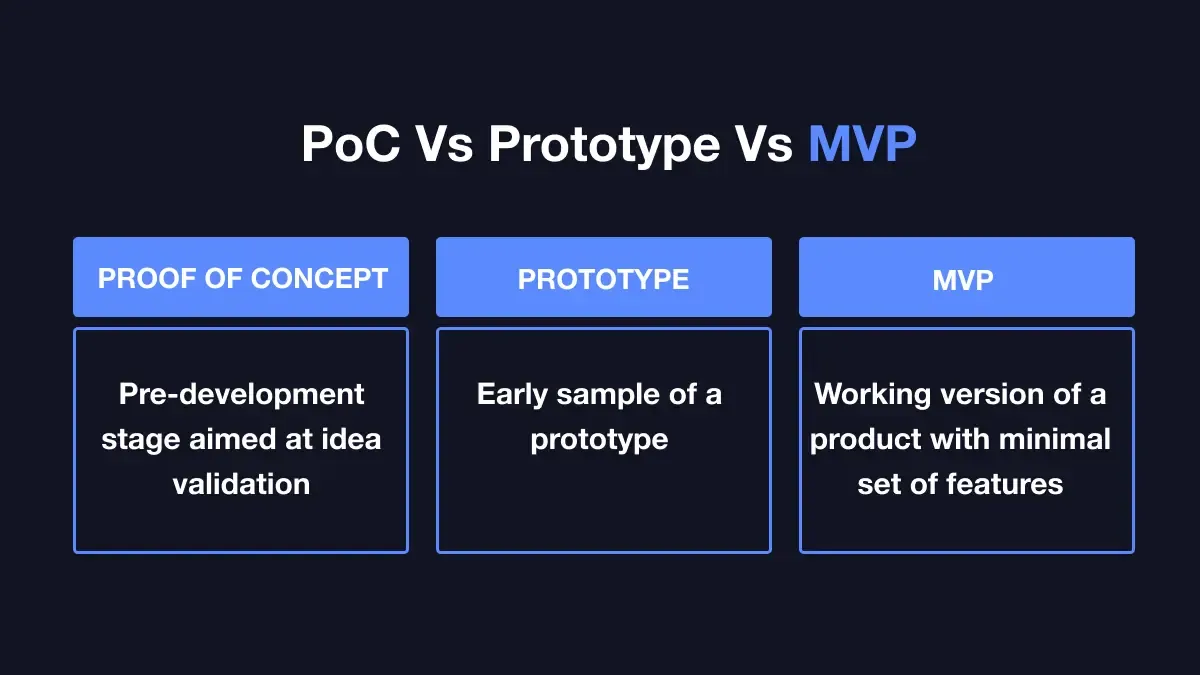EXPLORE
Got a Question? Connect with our experts.
Talk to an Expert
Got a Question? Connect with our experts.
Talk to an Expert
In the world of product development, three terms often come up: Proof of Concept (POC), Prototype, and Minimum Viable Product (MVP).
While all three are stages in the journey of turning an idea into a finished product, they each have distinct purposes, timelines, and deliverables.
If you are embarking on a new project, it is crucial to understand these differences, how they fit into your overall development process, and how to move from one stage to the next.
This article will guide you through each stage in detail, helping you identify where you are in the process, how to move forward, and what challenges to expect along the way.
Defining POC, Prototype, and MVP
Before diving into the stages and their progression, let us talk about each term clearly:
Proof of Concept (POC)

A Proof of Concept (POC) is the earliest stage of product development. It is used to validate whether an idea or concept is technically feasible.
A POC is essentially an experiment or a test designed to answer one key question:
Can this idea work?
The goal of a POC is not to create a fully functioning product but to demonstrate the possibility of implementing a particular idea or feature.
It is often used in scenarios where the technology or concept is unproven, and you need to reduce risk before proceeding further.
Prototype

A Prototype is an early version of the product built to show what the end product might look like and how it could function.
Prototypes are more developed than POCs because they focus on design and user experience, but they are still not ready for market launch.
The goal here is to visualize how the product might work in its final form, with a specific emphasis on UI/UX, flow, and features.
While a POC tests the feasibility of an idea, a Prototype demonstrates how users might interact with the product.
Minimum Viable Product (MVP)

The MVP is the first fully functional version of the product with the core features that solve the problem you are addressing.
An MVP has just enough features to satisfy early users and gather feedback but lacks the full set of features that the final product will offer.
The focus is on delivering value quickly while minimizing development time and costs.
The key difference between an MVP and a prototype is that the MVP is a working product, not just a visual representation or a test.
The primary goal of an MVP is to release a version that users can interact with in real-world scenarios, providing valuable feedback for future improvements.
Stages in Product Development - The Process and Progress

Now that we have defined each term, let us explore how these stages evolve and which comes first.
As you move through the stages, the focus shifts from validating an idea to refining the product and preparing it for market.
Stage 1 - Proof of Concept (POC)

The POC is the first step in the development journey, typically initiated when you have an idea but are not sure whether it is technically viable.
This stage is all about experimentation, feasibility testing, and risk reduction. Here, you might invest in developing specific technology, algorithms, or architectures that are crucial to your product.
The key focus during this stage would be asking the question:
“Can this idea work technically?”
If the answer is yes, then validating that idea is worth pursuing further.
This will help you minimize the uncertainty associated with unproven concepts.
How do you know you are still in the POC stage?
You are in your initial stage of product development, and you will realize you are still in your POC stage, when:
- Your product relies on technology that has not been proven yet.
- You need to test whether your idea can be translated into reality.
- You don't know yet if the product will be successful.
Example
If you are building an app that uses AI to recognize hand gestures for sign language, the feature you need to test in the POC is whether the AI can accurately recognize and interpret gestures, not the entire app.
Useful Tips
Start small. Focus on testing one key aspect of your product, such as a single technology or a critical function.
Set clear goals. Define specific criteria for success (e.g., whether the technology works as expected).
Before Moving to Stage 2
One of the key aspects of moving from the Proof of Concept (POC) to the Prototype stage is deciding which features to prioritize.
The POC stage is mainly about proving that your idea or core concept is technically feasible. You don’t need a fully fleshed-out product at this stage, just enough to show that the idea can work in principle.
In contrast, the Prototype stage involves translating the core concept into a visual representation or working model of the product.
This stage focuses heavily on design, usability, and user interactions.
While the core functionality of your product may not be fully developed, this is the point where you begin to visualize how features will come together.

At the POC stage, the focus is minimal, you are only concerned with a small set of features that demonstrate the technical feasibility of the concept.
Your primary objective is to test one critical aspect that validates whether the idea will even work. This could be a specific technology, a unique functionality, or a core feature that forms the backbone of your product.
Looking at the App Example
If your goal is to validate whether your AI-powered app can translate sign language in real-time, the POC would prioritize testing the AI algorithm for accuracy and speed.
It would not yet be concerned with the UI, the mobile platform, or the overall app design.
Stage 2 - Prototype

Once the POC is validated and the core idea has proven to be feasible, it is time to move to the Prototype stage.
Here, you are no longer just testing if an idea can work, but you are showcasing what the final product could look like (design).
Prototypes are meant to be low-cost, quick-to-build models that give stakeholders a sense of the user experience and the design.
While it may not be fully functional, it should capture the look and feel of the product, with a focus on design, usability, and user interactions.
Prototypes can be anything, from simple paper-based wireframes to interactive “clickable” versions developed in Figma.
At this stage
- Focus on visualizing and testing the user interface (UI) and user experience (UX).
- Get early input from potential users on design, features, and functionality.
- You want to measure interest and gather input from potential customers.
In the prototype stage:
- You need to see how users engage with the product, including the design and functionality.
- You are looking at the product's look, feel, and usability.
- You want to measure interest and gather input from potential customers.
Example
Let’s say your sign language app's core feature (POC) is functional AI recognition.
Now, in the Prototype stage, you prioritize features such as a simple UI where users can see how their gestures get translated into text, and an intuitive design that guides the user on how to make gestures.
It will not have tracking capabilities where it will capture hand gestures or translate into text. But, it will give a sense of how the app will work.
Useful Tips
Focus on a limited set of features that are crucial to the user experience. Gather feedback as early as possible to avoid wasting time on unnecessary features.
Stage 3 - Minimum Viable Product (MVP)

The MVP is the product in its simplest form, but with enough functionality to provide value to early users.
This stage is about testing the market with a working version of your product that delivers the core value proposition.
The MVP serves as the bridge between initial validation (POC and Prototype) and full-scale product development.
With the MVP, you aim to launch with minimal resources, prioritize essential features, and gather actionable feedback. This feedback is vital for refining your product before a full-scale release.
Your key focus in building your MVP should be
Core functionality - Focusing on the minimum set of features that deliver value.
Early Users - Launch the product to a small group of users and get feedback.
You will move from Prototype to MVP, when:
- You need to see if people are willing to pay for your product or if it resonates with your target audience.
- You need to focus on the most essential features that provide the most value to the users.
- You want to test your product in a real-world market before scaling.
Example
For the AI-powered sign language translation app, the MVP would include a working version of the app with basic functionality like the ability to capture hand gestures and translate them into text, while leaving out advanced features such as voice translation or customization options.
Key Differences Between POC, Prototype, and MVP
| Aspect | Proof of Concept (POC) | Prototype | Minimum Viable Product (MVP) |
|---|---|---|---|
| Goal | Validate feasibility of an idea | Visualise and test user experience | Build a functional product with core features |
| Functionality | Non-functional. Maybe a mock up or test | Partially functional. Shows design and flow | Fully functional but basic. Focuses on core features |
| Audience | Internal team, stakeholders | Potential users, design teams | Early adopters, customers |
| Development Time | Short term (weeks) | Short term (week to month) | Medium term (months) |
| Cost | Low (experimental) | Low to moderate (design focused) | Moderate (functional product) |
| User Feedback | Limited. Internal or expert feedback | Focused on design and UX feedback | Key to future development |
Frequently Asked Questions (FAQs)
What is the main difference between a POC and a Prototype?
A POC proves whether an idea is technically feasible, while a Prototype focuses on demonstrating the design and user interaction of a product, though it may not be fully functional.
Why is an MVP important?
An MVP allows you to test your product in real-world conditions, gather feedback from actual users, and reduce the risk of investing in features that users don't want. It helps you validate the product-market fit before investing heavily in full-scale development.
How do I know when I should move from one stage to the next?
Move from POC to Prototype when the concept is validated and you want to start gathering feedback on design, usability, and user flow. Transition to MVP when you're ready to test your product with actual users and validate the real-world value of your offering.
Can a POC be skipped?
In some cases, yes, especially if the technology or idea is already proven or well-understood. However, skipping the POC can increase risk, especially if you're working with unproven concepts, as it leaves critical technical feasibility untested.
Can a Proof of Concept be a fully functional product?
No, a POC is never intended to be a fully functional product. Its purpose is to demonstrate the feasibility of an idea or technology. It is usually a basic, experimental version with minimal functionality, not concerned with design, scalability, or user experience, which comes later.
Is it possible to skip the Prototype stage and go directly to MVP?
While it’s technically possible, skipping the Prototype stage and going directly to an MVP is generally not recommended. The Prototype stage is essential for gathering feedback on design and usability. Skipping it might result in a product that doesn’t resonate with users or has unrefined user flows. However, in simpler products or cases where you already have enough user insights, skipping the Prototype stage might be feasible.
Conclusion
Understanding the differences between Proof of Concept (POC), Prototype, and Minimum Viable Product (MVP) is crucial for any product development journey.
Each stage serves a unique purpose, helping you test and validate your idea, iterate on design, and refine functionality before launching. By following the correct process, you minimize risk, optimize resource allocation, and increase your chances of success.
With careful planning and thoughtful iteration, you will be well on your way to creating a product that meets the needs of your users and stands out in the market.
MVP Development Services
Looking for a reliable and easy-to-communicate MVP development team?
Talk to Zorica, Our MVP Expert





